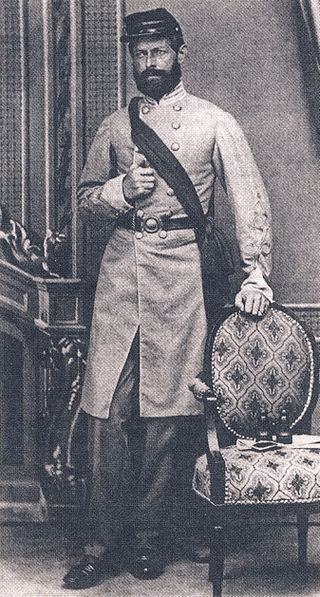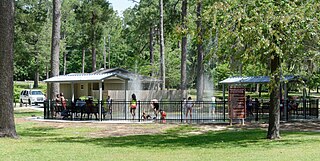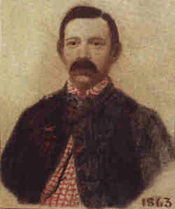
Millen is a city, and the county seat of Jenkins County, Georgia, United States. The population was 3,120 at the 2010 census, down from 3,492 at the 2000 census.

Sherman's March to the Sea was a military campaign of the American Civil War conducted through Georgia from November 15 until December 21, 1864, by William Tecumseh Sherman, major general of the Union Army. The campaign began on November 15 with Sherman's troops leaving Atlanta, recently taken by Union forces, and ended with the capture of the port of Savannah on December 21. His forces followed a "scorched earth" policy, destroying military targets as well as industry, infrastructure, and civilian property, disrupting the Confederacy's economy and transportation networks. The operation debilitated the Confederacy and helped lead to its eventual surrender. Sherman's decision to operate deep within enemy territory without supply lines was unusual for its time, and the campaign is regarded by some historians as an early example of modern warfare or total war.

Henry Wirz was a Swiss-born American military officer and convicted war criminal who served in the Confederate States Army during the American Civil War.

Magnolia Springs State Park is a 1,070-acre (430 ha) Georgia state park located between Perkins and Millen in Jenkins County. The park was built as a project of the Civilian Conservation Corps and opened in 1939. The park is well known for its crystal clear springs that are estimated to flow 7 million US gallons (26,000 m3) per day. The park also offers unique wildlife near the springs, including alligators, turtles, and a variety of birds and fish.

The Andersonville National Historic Site, located near Andersonville, Georgia, preserves the former Andersonville Prison, a Confederate prisoner-of-war camp during the final fourteen months of the American Civil War. Most of the site lies in southwestern Macon County, adjacent to the east side of the town of Andersonville. The site also contains the Andersonville National Cemetery and the National Prisoner of War Museum. The prison was created in February 1864 and served until April 1865.

Ronald Bryan Ginn, known as 'Bo' Ginn was an American politician who represented Georgia's 1st congressional district in the United States House of Representatives from 1973 to 1983.

Cahaba Prison, also known as Castle Morgan, was a prisoner of war camp in Dallas County, Alabama where the Confederacy held captive Union soldiers during the American Civil War. The prison was located in the small Alabama town of Cahaba, at the confluence of the Alabama and Cahaba rivers, not far from Selma. It suffered a serious flood in 1865. At the time, Cahaba was still the county seat, but that was moved to Selma in 1866. Cahaba Prison was known for having one of the lowest death rates of any Civil War prison camp mainly because of the humane treatment from the Confederate commandant.

Camp Douglas, in Chicago, Illinois, sometimes described as "The North's Andersonville," was one of the largest Union Army prisoner-of-war camps for Confederate soldiers taken prisoner during the American Civil War. Based south of the city on the prairie, it was also used as a training and detention camp for Union soldiers. The Union Army first used the camp in 1861 as an organizational and training camp for volunteer regiments. It became a prisoner-of-war camp in early 1862. Later in 1862 the Union Army again used Camp Douglas as a training camp. In the fall of 1862, the Union Army used the facility as a detention camp for paroled Confederate prisoners.

Johnson's Island is a 300-acre (120 ha) island in Sandusky Bay, located on the coast of Lake Erie, 3 miles (4.8 km) from the city of Sandusky, Ohio. It was the site of a prisoner-of-war camp for Confederate officers captured during the American Civil War. Initially, Johnson's Island was the only Union prison camp exclusively for Confederate officers but eventually it held privates, political prisoners, persons sentenced to court martial and spies. Civilians who were arrested as guerrillas, or bushwhackers, were also imprisoned on the island. During its three years of operation, more than 15,000 men were incarcerated there.

Camp Randall was a United States Army base in Madison, Wisconsin, the largest staging point for Wisconsin troops entering the American Civil War. At this camp fresh volunteers received quick training before heading off to join the Union Army. Also located on the grounds were a hospital and briefly a prisoner-of-war camp for captured Confederate soldiers.

The Florence Stockade, also known as The Stockade or the Confederate States Military Prison at Florence, was a Confederate prisoner-of-war camp located on the outskirts of Florence, South Carolina, during the American Civil War. It operated from September 1864 through February 1865; during this time, as many as 18,000 Union soldiers were imprisoned there, about 2,800 of whom died.

The siege of Fort Pulaski concluded with the Battle of Fort Pulaski fought April 10–11, 1862, during the American Civil War. Union forces on Tybee Island and naval operations conducted a 112-day siege, then captured the Confederate-held Fort Pulaski after a 30-hour bombardment. The siege and battle are important for innovative use of rifled guns which made existing coastal defenses obsolete. The Union initiated large-scale amphibious operations under fire.
The 14th New Hampshire Infantry Regiment was an infantry regiment that participated in the American Civil War. It was the last three-year regiment raised in New Hampshire, serving from September 24, 1862, to July 8, 1865. Carroll Davidson Wright was one of its regimental leaders. The regiment lost a total of 232 men during its service; 8 officers and 63 enlisted men killed and mortally wounded, 4 officers and 151 enlisted men by disease.

Camp Ford was a POW camp near Tyler, Texas, during the American Civil War. It was the largest Confederate-run prison west of the Mississippi.
John McElroy (1846–1929) was an American printer, soldier, journalist and author, known mainly for writing the novel The Red Acorn and the four-volume Andersonville: A Story of Rebel Military Prisons, based upon his lengthy confinement in the Confederate Andersonville prison camp during the American Civil War.

Robert Knox Sneden (1832–1918) was an American landscape painter and a map-maker for the Union Army during the American Civil War. He was a prolific illustrator and memoirist documenting the war and other events.

Father Peter Whelan was an Irish-born Catholic priest who distinguished himself as a chaplain for both Confederate troops and Union prisoners of war during the American Civil War. Father Whelan previously served as a missionary in North Carolina and pastor of Georgia's first Catholic parish, and twice served as administrator of the entire Diocese of Savannah.

Between 1861 and 1865, American Civil War prison camps were operated by the Union and the Confederacy to detain over 400,000 captured soldiers. From the start of the Civil War through to 1863 a parole exchange system saw most prisoners of war swapped relatively quickly. However, from 1863 this broke down following the Confederacy's refusal to treat black and white Union prisoners equally, leading to soaring numbers held on both sides.

The 33rd Massachusetts Volunteer Infantry was an infantry regiment that served in the Union Army during the American Civil War.
The Battles of Tilton were two one-day skirmishes in the American Civil War. The first of which was during the Atlanta Campaign, the second was during Hood's Tennessee Campaign. The battles were fought in Tilton, Georgia, in Whitfield County, located a few miles south of Dalton, Georgia, near the Conasauga River.




















